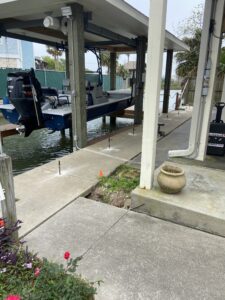Concrete Seawall Repair-Galveston Texas
Project Type: Concrete Seawall Repair, Void Fill
Location: Galveston, TX
Problem:
Concrete Alignment Technology (C.A.T.FOAM) was called by a homeowner who noticed some erosion behind the concrete seawall at his bay home in Galveston, TX. The property was located on a canal which connects to Galveston Bay. Due to poor rainwater drainage around the home, tidal movement, among other variables, there was an extreme loss of soils around the property. This erosion had created a substantial void and cavity underneath portions of the home’s foundation and the entire 110 linear feet of sidewalk that connects to the seawall barrier cap. Furthermore, after performing multiple soil tests along the seawall barrier, using a Dynamic Cone Penetrometer, the soil testing report indicated weak soils at the 6.5 ft depth which was calculated to be just below the water level at high tide. It was also noted that the location of the voids and unstable soils were consistent with the seams where the concrete panels were joined.
Summary:
The homeowner had already explored other options to repair his failing seawall but was unsatisfied with the price. One of the alternatives was quoted to be well over $50,000 and a minimum of 3 weeks to complete. The alternative option would have required an extremely invasive process of ripping up the entire connecting sidewalk and excavating around the home and seawall. The homeowner decided to go with C.A.T.FOAM’s non-invasive option which included a two stage process using HMI™ polymer resin technologies. Firstly, stabilizing the deeper subgrade soils followed by filling the large voids and cavities underneath the connecting sidewalk and home’s foundation.
Solution:
C.A.T.FOAM completed the soil stabilization process using HMI’s Deep Foamjection™ method. The Deep Foamjection™ method consisted of injecting high density polyurethane foam to specified depths behind the seawall in order to reestablish the load-bearing capacity of the soils and sealing the concrete panels from future water intrusion. The material used for this stage of the project was HMI’s expansive polyurethane 402-HydroFoam due to its tremendous hydro-insensitive polymers and ability to set up in wet environments. For the soil stabilization stage, a total of 22 injection points were installed behind the seawall and approximately 55-70 lbs of foam was pumped per injection point at specified depths of 6.5 ft and 3.5 ft into the subgrade. A total of 1,300 lbs of 402-HydroFoam material was installed along the seawall barrier. The second stage of the project, void filling, was completed using FillRite Technologies FillFoam™ material which is a pre-expanded flowable foam engineered for large void fills and soil stabilization applications. FillFoam™ is hydro-insensitive, highly versatile, and is an excellent engineered material for soil repairs and improvements. For this stage, a total of 2,180 lbs of FillFoam™ material was installed at a density of 8 lbs/ft3 in order to sufficiently fill the voids underneath the edge of the home’s foundation and underneath the 110 linear feet of connecting sidewalk.
Conclusion:
The two stage process of soil stabilization and void filling was completed in a total of 50 hours, roughly 5 full days of work. The customer was extremely pleased with the success of the project, saving him time and thousands of dollars all while completing the operations with minimal invasiveness to the surrounding environment.




